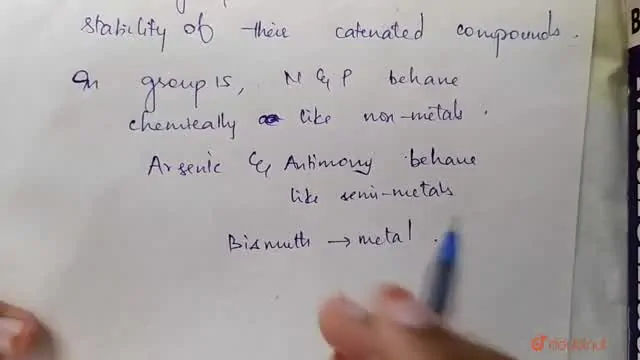Discuss the trends in chemical reactivity of group 15 elementsSolution in Telugu
Nitrogen gas exists as diatomic molecule. Dut to the presence of triple bond between Base N - Atoms bond dissociation energy is high (941.4 KJ / mol). Hence nitrogen is inert and unreactive.
Phosphorus is a tetra atomic molecule and P-P single bond is weaker than N≡N. P - P bond dissociation energy U 213 KJ/mole. Hence phosphorus is more reactive than Nitrogen.
Explanation :
→ The single N-N bond is weaker than the single P-P bond due to high inter electronic repulsion of the non-bonding electrons in N2 because of small bond length. There fore the catenation property is weaker in nitrogen as compound to phosphorares.
R3 P = O exist but R3N = O does not.
Explanation :
→ Nitrogen does not form dπ−Pπ multiple bond with oxygen because of lack of d - orbitals in Nitrogen atom. But in case of R3N=0 the value of nitrogen should be 5. So these compounds do not exist where as in case of 'P' atom d-orbitals are available. So P-atom can able to form dπ−Pπ multiple bonds hence R3P=0 exist.
i) Reactivity towards hydrogen : Group - 15 elements forms EH3 type hydrides (E = Group - 15 elements)
Eg : PH3,NH3,AsH3,BiH3,SbH3.
→ Among above hydrides NH3 is mild reducing agent while BiH3 is strong reducing agent.
→ Stability of hydrides decreases from NH3 to BiH3.
→ Basicity of hydrides decreases as follows.
NH3>PH3>AsH3>SbH3>BiH3.
ii) Reactivity towards Oxygen : These forms two types of oxides E2O3 and E2O5.
Eg : P2O3,N2O5,N2O3,P2O5.
→ Acidic character of oxides decrease down the group.
→E2O3 of N and P are acidic, As and Sb are amphoteric while 'Bi' is basic.
iii) Reactivity towards halogens : These elements forms two types of halides EX3 and EX5.
→ 'N' - does not form penta halides due to lack of the d-orbitals.
→ Penta halides are more covalent than tri halides because the elements in higher oxidation state have more polarising power.
iv) Reactivity towards metals : All these elements react with metals to form their binary compounds containing - 3 oxidation state.
Eg : Ca3N2,Ca3P2 etc.
Related Playlists
- BOOK - VIKRAM PUBLICATION ( ANDHRA PUBLICATION)CHAPTER - P-BLOCK ELEMENTS EXERCISE - GROUP 16 ELEMENTS (SHORT ANSWER QUESTIONS)21videos
P-BLOCK ELEMENTS
- BOOK - VIKRAM PUBLICATION ( ANDHRA PUBLICATION)CHAPTER - P-BLOCK ELEMENTS EXERCISE - GROUP 17 ELEMENTS (SHORT ANSWER QUESTIONS)10videos
P-BLOCK ELEMENTS
- BOOK - VIKRAM PUBLICATION ( ANDHRA PUBLICATION)CHAPTER - P-BLOCK ELEMENTS EXERCISE - GROUP - 18 ELEMENTS (VERY SHORT ANSWER QUESTIONS)23videos
P-BLOCK ELEMENTS
- BOOK - VIKRAM PUBLICATION ( ANDHRA PUBLICATION)CHAPTER - ORGANIC COMPOUNDS CONTAINING NITROGENEXERCISE - DAM SURE (SAQ - 8 Marks)15videos
ORGANIC COMPOUNDS CONTAINING NITROGEN
- BOOK - VIKRAM PUBLICATION ( ANDHRA PUBLICATION)CHAPTER - POLYMERSEXERCISE - INTEXT QUESTIONS6videos
POLYMERS
Similar Questions
Justify the placement of O, S, Se, Te and Po in the same group of the periodic table in terms of electronic configuration, oxidation states and hydride formation.
02:00View SolutionHow can you prepare Cl2 from HCl and HCl from Cl2 ? Write the reactions.
02:05View SolutionWhat inspired Bartlett for carrying out reaction between Xe and PtF6 ?
04:12View SolutionExplain the following name reactions :
Sandmeyer reaction04:12View SolutionWhat are polymers ? Give example.
06:04View SolutionDiscuss the trends in chemical reactivity of group 15 elements.
43:14View SolutionDiscuss and compare the trend in ionisation enthalpy of the elements of group 1 with those of group 17 elements.
01:49View Solutionसमूह 15 के तत्वों की रासायनिक सक्रियता के व्यवहार की विवेचना कीजिए।
03:09View Solutionवर्ग 15 के तत्वों की रासायनिक क्रियाशीलता की प्रवृति की विवेचना कीजिये|
04:36View SolutionDiscuss trends in chemical reactivity of Gr-15 elements.
View SolutionPeriodic Trends and Chemical Reactivity
03:32View SolutionDiscuss the trends in chemical reactivity of group 15 elements
View SolutionDiscuss the trends in chemical reactivity of group 15 elements.
View SolutionDiscuss the trends in ionisation enthalpies and electronegativity of group-15 elements.
View SolutionDiscuss reactivity of group-15 elements with metals.
View Solution


